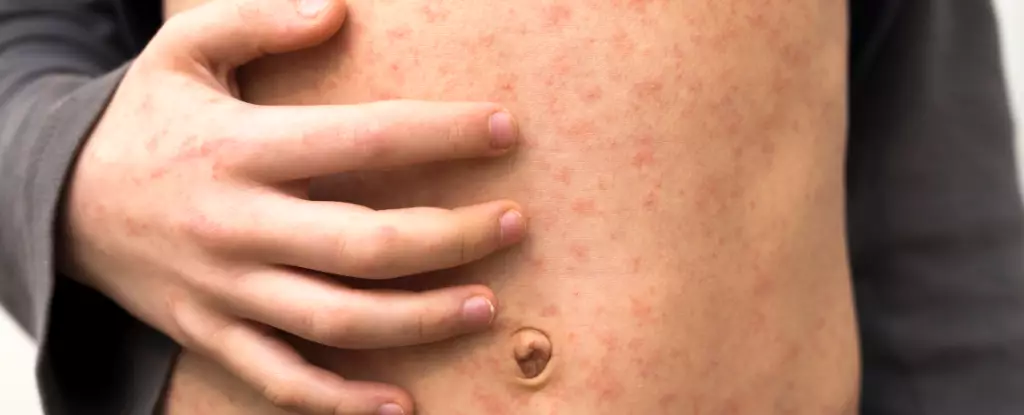In the shadows of a successful vaccination history lies a startling resurgence of measles in the United States, specifically delineated by an outbreak that has escalated since late January 2025. With over 400 confirmed cases in Texas and more than 50 in adjacent states like New Mexico and Oklahoma by March 28, it is clear that the scarlet disease, once thought to be relegated to the annals of medical history, is making a dangerous comeback. Public health officials are alarmed, concerned that the real numbers may be significantly underreported as they trace potential exposures linked to various modes of travel and public spaces, including airports and trains. The current state of malaise surrounding measles infections paints a dire picture—a vivid reminder that complacency can have dire consequences.
The Clinical Implications of Measles
Measles is notoriously more than a mere childhood illness characterized by a fever and rash. Its clinical implications are frighteningly serious. To date in 2025, 14% of those infected have required hospitalization, an impressive reduction compared to 40% the previous year, yet still a cause for intense concern. The disease does not discriminate; it is particularly dangerous for younger children, leading to complications such as viral pneumonia which can often become life-threatening. The reality is that measles can inflict severe damage on bodily systems, including the lungs and central nervous system, leading to long-lasting complications or fatal outcomes. Descriptions of measles may downplay its risks, but a holistic understanding of its potential devastation is essential for public awareness.
The Perilously Contagious Nature of Measles
What casts an ominous shadow over this outbreak is the sheer contagiousness of the measles virus. An unvaccinated individual has a staggering 90% chance of contracting the illness when exposed to an infected person. This leaves unvaccinated communities particularly vulnerable. The vaccine, however, offers a robust safeguard; a two-dose regimen guarantees a 97% effectiveness rate in preventing the disease. The accessible and lifesaving nature of the vaccine begs the question: why has hesitancy around vaccination persisted among certain populations? An elaborate tapestry of misinformation has woven a web of fear and skepticism, enabling a resurgence of this once-contained virus.
The Mechanism of Infection: A Biological Perspective
The mechanism through which measles exerts its damaging effects is both fascinating and terrifying. Once the virus enters the body, it swiftly binds to specific cellular proteins and infiltrates host cells, causing widespread devastation. Conduction of the virus typically begins in the upper respiratory system before penetrating the lungs. It targets immune cells and spreads through the lymphatic system, paving the way for systemic infection. Deterioration of the lung tissue is a primary reason that individuals with measles find themselves hospitalized, often developing pneumonia that results in extreme respiratory distress. The implications of this viral onslaught extend far beyond respiratory failure; the overarching ramifications for the immune system itself are staggering.
Long-Term Consequences: Beyond Immediate Symptoms
For survivors, measles can leave behind a legacy of permanent damage. The virus does not merely attack the body; it launches an insidious assault on the immune system, leaving individuals vulnerable to future infections. Alarmingly, the aftermath of measles can manifest years later in the form of subacute sclerosing panencephalitis (SSPE), a progressive condition leading to fatal dementia in some cases. The evolution of the measles virus during initial infection raises critical questions in virology. If measles can mutate to evade detection by our immune systems, the implications for treatment and prevention are significant.
Moreover, the intersection of immunity and vaccination highlights a critical need for ongoing public education regarding immunizations. Countries that have consistently promoted vaccination programs have experienced lower incidences of diseases like measles. It is particularly vital to inspire a renewed cultural commitment to vaccination, especially during times of resurgence, lest we jeopardize the generations that rely on these preventive measures.
The Path Forward: Vaccination is Key
As we face this troubling resurgence of measles, it becomes evident that the best defense lies not in reactive public health strategies but in proactive vaccination campaigns. The advantages of widespread immunization far outweigh the ephemeral satisfaction of avoiding vaccines. Researchers are already investigating potential therapies for severe cases of measles, yet no treatment can rival the efficacy of preventive measures. The narrative surrounding vaccination should not be one of debate but rather one of unity for a collective endeavor to shield our communities. Amidst an evolving landscape of public health, the commitment to vaccination must stand firm—our past victories against measles must not be written off as merely historical footnotes.

